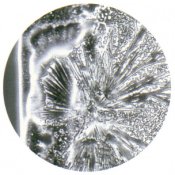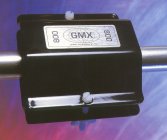MAGNETOHYDRODYNAMICS:
THE EFFECT OF MAGNETS ON FLUIDS
WATER:
THE SCALE BUILD-UP DILEMMA
Water is one of the world's best solvents. In fact, we refer to it as the "universal solvent." Given enough time, it will dissolve any organic or inorganic material. It surrounds foreign particles, such as minerals, entrapping them in what scientists refer to as "complexes." That's why water usually has a high mineral content. These dissolved minerals are not a part of the water itself. They are "captives" that the water has surrounded and is carrying along with it. The number of mineral complexes in water determines how "hard" the water is. The more minerals it carries, the harder it is considered to be.
When water is stored, heated, or evaporates, the complexes it carries are broken up and the dissolved minerals are set free. These liberated minerals[most of which are calcium carbonate or magnesium conglomerate in sediments that line the insides of pipes, appliances, water heaters, and other surfaces with which the water comes in contact. Over time, more and more minerals build up on the sediment layer, causing it to grow progressively thicker. There is a name for these caked-on mineral deposits: scale. The limestone that forms the Swiss Alps and Mexico's Yucatan Peninsula is basically scale. Lime scale is a very hard substance, and removing it from plumbing fixtures and appliances is a difficult task.
Most of the water that is piped into homes and other buildings in North America and many other countries contains a significant amount of hardness minerals. This is both good and bad. It's good because the right amount of minerals has healthful benefits and make the water taste better. It's bad because some of these dissolved minerals are converted to scale when the water goes into a home or building and is stored, heated or evaporates. It's a well-known fact that letting hard lime scale build up in the plumbing fixtures and appliances in your home is like pouring money down the drain.
The solution? There are several, but only one that makes sense.
To date, the most common solution is the traditional water softener, which takes a portion of the hardness minerals out of the water and replaces them with sodium. Water thus treated is not recommended for drinking because of the high sodium content. Water softeners are also expensive to buy and operate, and can cause environmental problems. Also, they do not stop scale build-up, nor do they remove scale that has already built up. They simply reduce scale. These are just a few of the reasons why water softeners are not an acceptable solution to scale build-up problems.
Other scale build-up remedies, such has acid washes and chemical additives have even greater drawbacks, including the risk of contamination and the fact that they wear out the surfaces they contact.
What, then, is the acceptable way to combat scale build-up? The answer lies in a complex word that for a fairly simple physical phenomenon: magnetohydrodynamics. Simply stated, magnetohydrodynamics is what happens when water passes through a properly focused magnetic field. The magnetic field breaks up some of the complexes that are carried in the water, freeing the captive mineral particles. Once free, these particles act as crystallization centers, giving the surrounding mineral molecules in the water something to "stick" to rather then forming new layers of scale on the inside of plumbing and appliance surfaces. As these crystallization centers attract mineral molecules, they form circular platelets, which remain in the water rather the attaching them selves to surfaces and causing scale build-up.
The net effect of all this is that the hardening minerals are changed from a scale like ice cube to a powder like a snowflake.
This process of keeping minerals in the water rather then letting them precipitate out in the form of scale when heating or evaporation takes place is known as magnetic fluid conditioning.
 |
 |
Untreated Water:
Microscopic photo of untreated water with hardness of 140 ppm, magnified 400x. |
Treated with GMX:
Same water after treatment with GMX Model 800, magnified 400x |
It is not a new process. Nor is it unproven. Patents for treating water with magnetics appeared back in the 1950's. Even back then, when magnets were far weaker then they are today, the effects were remarkable. The treated water behaved as if it were "softer" with less mineral content, and scale build-up was significantly reduced.
Magnetic fluid conditioning caught on first in the eastern world, where other water softening methods and equipment were not commonly available. Highly favorable reports soon began filtering back from China, Russia, Poland, Bulgaria, and other eastern countries about water that was being treated with magnetics not only for residential use, but also for agricultural, commercial, and industrial use.
In the developed countries of the western world, where chemical and other water softening systems were well entrenched, magnetic fluid conditioning took longer to gain acceptance. But its benefits were to dramatic to remain obscure for long. Systematic research from respected institutions began to be conducted, quantitative methods were developed to evaluate the effectiveness of magnetic water conditioning devices, and the findings revealed overwhelmingly positive effects.
In 1973 for example, the United States Government confirmed that magnetic fluid conditioning is an effective means of controlling scale. A study by National Technical Information Services for the United States Air Force revealed that magnetized water will not form scale on heating surfaces; that properly designed and installed magnetic units will prevent the formation of costly scale build-up.
A good thing got even better with the development and availability of a new generation of extremely powerful, permanent magnets. These ceramic magnets are a hundred times more powerful than the old fashioned steel magnets. They are also more durable and are permanent. In fact, once a ceramic magnet is magnetized it never needs recharging. Nor does it require an energy source to keep it magnetized. These magnets maintain their strength so completely that they are used in nuclear submarines to ensure accuracy in subpolar navigation. This is one reason GMX can offer its customers a lifetime warranty.
FUEL:
INCOMPLETE COMBUSTION
Water is not the only fluid that can benefit from magnetohydrodynamics. Subjecting gasoline and diesel fuel to a magnetic field results in more complete combustion of that fuel.
Magnetically treated fuel has a tendency to attract oxygen molecules when mixed with air in a combustion cylinder. The result is a more efficient and complete combustion of the fuel throughout the entire chamber, generating more energy from the same amount of fuel, and reducing environmentally harmful hydrocarbon emissions. Whether it's water for your home, office, or swimming pool, or fuel for your vehicles, magnetohydrodynamics makes a positive difference. Magnetic fluid conditioning is a technology that is here to stay. |

